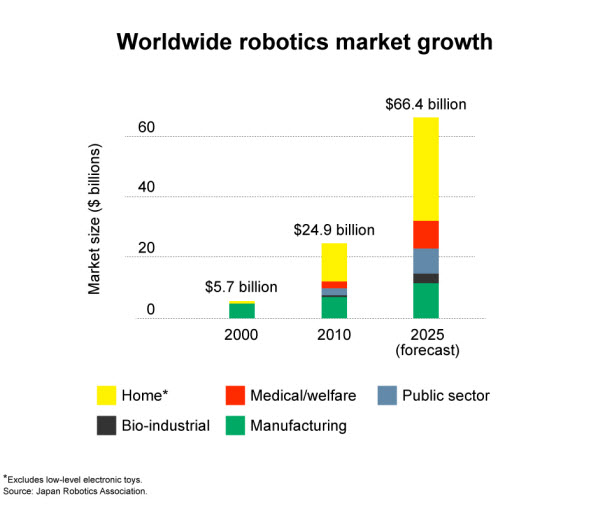The Rise of Robots and Automation
November 2014By FIDELITY VIEWPOINTS

If you call room service at the Starwood (HOT) Hotel in Palo Alto, California, a robot butler may arrive to bring you a fresh towel.
At the Children’s Hospital at Vanderbilt in Nashville, nurses rely on a robotic system to prepare IV solutions and shots for patients.
How about a robot who keeps your kids company while they go to sleep? Reminiscent of the Jetsons, a new family robot named Jibo promises to do just that.

Sign up for Kiplinger’s Free E-Newsletters
Profit and prosper with the best of expert advice on investing, taxes, retirement, personal finance and more - straight to your e-mail.
Profit and prosper with the best of expert advice - straight to your e-mail.
Even the AP news service is going robotic. It plans to publish thousands of earnings articles this year, produced entirely by an automated service.
These are just a few examples of how declining costs and technological advances are bringing robotics and automation technology to smaller businesses, local shops, and perhaps most captivatingly, our homes.
“I think autonomous robots are going to be very common in households in the next 20 years,” says Gavin Baker, manager of Fidelity® OTC Fund (FOCPX). Indeed, some advanced, autonomous features are just over the horizon.
In the car space, for instance, driverless cars may be available at dealerships in 10 to 15 years. Google (GOOG) plans to roll out a few test cars this year. And BMW, Volvo, and Mercedes are gearing up to offer several autonomous features in the market this year (see table). “Thanks to cheaper, more flexible products, robotics and automation have reached an inflection point that should see use increase dramatically in the coming years,” says Charlie Chai, manager of Fidelity® Technology Portfolio (FSPTX). “It will have big implications for the kinds of jobs people do, and how we live.”
Innovations creating flexibility
Robotics and automation are expanding, thanks to a convergence of technological breakthroughs.
Sensors have evolved, allowing machines to become more aware of their environment. This enables them to handle new tasks and operate in new places. Smaller and more powerful controllers and processors—and the power of cloud computing—have helped machines become more flexible and cheaper.
"These technologies are opening doors to completely new applications for robots,” said Dr. Andreas Bauer, Chairman of the IFR Industrial Robot Suppliers Group. “Impressive for me are the opportunities that are provided in new fields for automation, especially in areas where no robots are currently used."
The result is a market that appears poised to grow rapidly for many years.
Potential investment opportunities
Investors may be able to tap into this breakthrough idea by investing directly in robotics manufacturers (see chart).

Plus, there are other less direct plays, including sensor manufacturers, processor companies, or hardware suppliers.
“Today, I think the most compelling opportunities lie with sensor manufacturers, and industrial automation manufacturers,” says Chai. “But I see this as a multiyear growth story.”
Digging deeper, Chai sees the best opportunities in component makers (e.g., sensors and motors), automation vendors (e.g., controllers and software platform companies), and system vendors that design and make the robots, among others.
In terms of value, a few of the pure-play robotics companies may be expensive. “However, growth is likely to be very significant over the next few decades, with current penetration still very low,” Chai notes.
Learn more
Charlie Chai manages Fidelity Select Information Technology Portfolio
Gavin Baker manages Fidelity OTC Fund
Find more investing ideas with Fidelity Viewpoints
Past performance is no guarantee of future results.
The information presented reflects the opinions of the speaker as of September 3, 2014. These opinions do not necessarily represent the views of Fidelity or any other person in the Fidelity organization and are subject to change at any time based on market or other conditions. Fidelity disclaims any responsibility to update such views. These views may not be relied on as investment advice and, because investment decisions for a Fidelity fund are based on numerous factors, may not be relied on as an indication of trading intent on behalf of any Fidelity fund.
Because of their narrow focus, sector investments tend to be more volatile than investments that diversify across many sectors and companies.
Gavin Baker manages Fidelity OTC Fund, which invests in some of the stocks mentioned in this article. As of July 31, the fund held 0.067% of assets in iRobot Corp.
As with all your investments through Fidelity, you must make your own determination as to whether an investment in any particular security or fund is consistent with your investment objectives, risk tolerance, financial situation, and your evaluation of the investment option. Fidelity is not recommending or endorsing any particular investment option by mentioning it in this article or by making it available to its customers. This information is provided for educational purposes only, and you should bear in mind that laws of a particular state and your particular situation may affect this information.
Indexes are unmanaged. It is not possible to invest directly in an index.
Stock markets are volatile and can fluctuate significantly in response to company, industry, political, regulatory, market, or economic developments. Investing in stock involves risks, including the possible loss of principal.
Keep in mind that investing involves risk. The value of your investment will fluctuate over time and you may gain or lose money.
Votes are submitted voluntarily by individuals and reflect their own opinion of the article's helpfulness. A percentage value for helpfulness will display once a sufficient number of votes have been submitted.
Fidelity Brokerage Services LLC, Member NYSE, SIPC, 900 Salem Street, Smithfield, RI 02917
698304.4.0
This content was provided by Fidelity Investments and did not involve the Kiplinger editorial staff.
Get Kiplinger Today newsletter — free
Profit and prosper with the best of Kiplinger's advice on investing, taxes, retirement, personal finance and much more. Delivered daily. Enter your email in the box and click Sign Me Up.
-
 Stock Market Today: Stocks Gain on Tech, Auto Tariff Talk
Stock Market Today: Stocks Gain on Tech, Auto Tariff TalkThe Trump administration said late Friday that it will temporarily halt tariffs on some Chinese tech imports.
By Karee Venema
-
 Sam's Club Plans Aggressive Expansion: Discover Its New Locations
Sam's Club Plans Aggressive Expansion: Discover Its New LocationsSam's Club expansion plans will open up to 15 new stores each year. Learn where they plan to open in 2025.
By Sean Jackson
-
 All AI Regulations Are Not Created Equal: Kiplinger Economic Forecasts
All AI Regulations Are Not Created Equal: Kiplinger Economic ForecastsEconomic Forecasts As Congress regulates artificial intelligence, tech advocates urge lawmakers to define different areas of AI, as some are more dangerous than others.
By John Miley
-
 Best Banks for High-Net-Worth Clients
Best Banks for High-Net-Worth Clientswealth management These banks welcome customers who keep high balances in deposit and investment accounts, showering them with fee breaks and access to financial-planning services.
By Lisa Gerstner
-
 Text-Generating AI Faces Major Legal Risks: Kiplinger Economic Forecasts
Text-Generating AI Faces Major Legal Risks: Kiplinger Economic ForecastsEconomic Forecasts Major legal risks to text-generating artificial intelligence: Kiplinger Economic Forecasts
By John Miley
-
 Stock Market Holidays in 2025: NYSE, NASDAQ and Wall Street Holidays
Stock Market Holidays in 2025: NYSE, NASDAQ and Wall Street HolidaysMarkets When are the stock market holidays? Here, we look at which days the NYSE, Nasdaq and bond markets are off in 2025.
By Kyle Woodley
-
 Stock Market Trading Hours: What Time Is the Stock Market Open Today?
Stock Market Trading Hours: What Time Is the Stock Market Open Today?Markets When does the market open? While the stock market does have regular hours, trading doesn't necessarily stop when the major exchanges close.
By Michael DeSenne
-
 Bogleheads Stay the Course
Bogleheads Stay the CourseBears and market volatility don’t scare these die-hard Vanguard investors.
By Kim Clark
-
 The Current I-Bond Rate Until May Is Mildly Attractive. Here's Why.
The Current I-Bond Rate Until May Is Mildly Attractive. Here's Why.Investing for Income The current I-bond rate is active until November 2024 and presents an attractive value, if not as attractive as in the recent past.
By David Muhlbaum
-
 What Are I-Bonds? Inflation Made Them Popular. What Now?
What Are I-Bonds? Inflation Made Them Popular. What Now?savings bonds Inflation has made Series I savings bonds, known as I-bonds, enormously popular with risk-averse investors. So how do they work?
By Lisa Gerstner